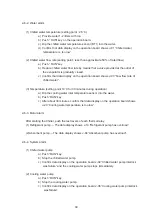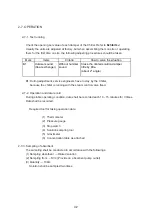
1-11-7. Bubble test
(1) Instruments
a) Attachment of exhaust port of purge pump
b) Graduated cylinder
c) Vinyl hose (6 mm
φ
)
d) Bucket
e) Putty
f) Stop watch
g) Vacuum gauge (0-10hPa)
(2) Standard
Model
Standard value
TSA-LJ-11
Less than 15 cc per 10 min.
12
Less than 15 cc per 10 min.
13
Less than 15 cc per 10 min.
14
Less than 15 cc per 10 min.
21
Less than 25 cc per 10 min.
22
Less than 25 cc per 10 min.
23
Less than 25 cc per 10 min.
24
Less than 30 cc per 10 min.
31
Less than 30 cc per 10 min.
32
Less than 30 cc per 10 min.
41
Less than 40 cc per 10 min.
42
Less than 40 cc per 10 min.
51
Less than 45 cc per 10 min.
52
Less than 45 cc per 10 min.
53
Less than 50 cc per 10 min.
21
Summary of Contents for LJ
Page 1: ...Absorption Chiller INSTALLATION MANUAL LJ Model ...
Page 26: ...Fig 1 11 7 23 ...
Page 30: ... marks are the positions measured by the megger 27 ...
Page 36: ...33 ...
Page 37: ...34 ...
Page 46: ...13 Sampling of absorbent Sampling of absorbent Finished Unfinished 43 ...
















































